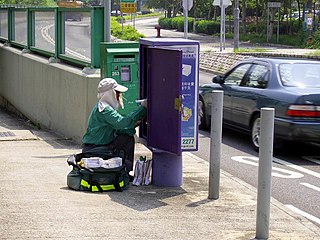Related Research Articles

Electronic mail is a method of transmitting and receiving messages using electronic devices. It was conceived in the late–20th century as the digital version of, or counterpart to, mail. Email is a ubiquitous and very widely used communication medium; in current use, an email address is often treated as a basic and necessary part of many processes in business, commerce, government, education, entertainment, and other spheres of daily life in most countries.

A letter is a written message conveyed from one person to another through a medium. Something epistolary means that it is a form of letter writing. The term usually excludes written material intended to be read in its original form by large numbers of people, such as newspapers and placards, although even these may include material in the form of an "open letter". The typical form of a letter for many centuries, and the archetypal concept even today, is a sheet of paper that is sent to a correspondent through a postal system. A letter can be formal or informal, depending on its audience and purpose. Besides being a means of communication and a store of information, letter writing has played a role in the reproduction of writing as an art throughout history. Letters have been sent since antiquity and are mentioned in the Iliad. Historians Herodotus and Thucydides mention and use letters in their writings.
Jargon is the specialized terminology associated with a particular field or area of activity. Jargon is normally employed in a particular communicative context and may not be well understood outside that context. The context is usually a particular occupation, but any ingroup can have jargon. The main trait that distinguishes jargon from the rest of a language is special vocabulary—including some words specific to it and often different senses or meanings of words, that outgroups would tend to take in another sense—therefore misunderstanding that communication attempt. Jargon is sometimes understood as a form of technical slang and then distinguished from the official terminology used in a particular field of activity.

The mail or post is a system for physically transporting postcards, letters, and parcels. A postal service can be private or public, though many governments place restrictions on private systems. Since the mid-19th century, national postal systems have generally been established as a government monopoly, with a fee on the article prepaid. Proof of payment is usually in the form of an adhesive postage stamp, but a postage meter is also used for bulk mailing.
Human communication, or anthroposemiotics, is a field of study dedicated to understanding how humans communicate. Humans' ability to communicate with one another would not be possible without an understanding of what we are referencing or thinking about. Because humans are unable to fully understand one another's perspective, there needs to be a creation of commonality through a shared mindset or viewpoint. The field of communication is very diverse, as there are multiple layers of what communication is and how we use its different features as human beings.

Before the development of photographic copiers, a carbon copy was the under-copy of a typed or written document placed over carbon paper and the under-copy sheet itself. When copies of business letters were so produced, it was customary to use the acronym "CC" or "cc" before a colon and below the writer's signature to inform the principal recipient that carbon copies had been made and distributed to the parties listed after the colon. With the advent of word processors and e-mail, "cc" is used as a merely formal indication of the distribution of letters to secondary recipients.
Word of mouth, also called viva voce, is the passing of information from person to person using oral communication, which could be as simple as telling someone the time of day. Storytelling is a common form of word-of-mouth communication where one person tells others a story about a real event or something made up. Oral tradition is cultural material and traditions transmitted by word of mouth through successive generations. Storytelling and oral tradition are forms of word of mouth that play important roles in folklore and mythology. Another example of oral communication is oral history—the recording, preservation and interpretation of historical information, based on the personal experiences and opinions of the speaker. Oral history preservation is the field that deals with the care and upkeep of oral history materials collected by word of mouth, whatever format they may be in.
Communications management is the systematic planning, implementing, monitoring, and revision of all the channels of communication within an organization and between organizations. It also includes the organization and dissemination of new communication directives connected with an organization, network, or communications technology. Aspects of communications management include developing corporate communication strategies, designing internal and external communications directives, and managing the flow of information, including online communication. It is a mere process that helps an organization to be systematic as one within the bounds of communication.
An invoice, bill or tab is a commercial document issued by a seller to a buyer relating to a sale transaction and indicating the products, quantities, and agreed-upon prices for products or services the seller had provided the buyer.
An outline, also called a hierarchical outline, is a list arranged to show hierarchical relationships and is a type of tree structure. An outline is used to present the main points or topics (terms) of a given subject. Each item in an outline may be divided into additional sub-items. If an organizational level in an outline is to be sub-divided, it shall have at least two subcategories, although one subcategory is acceptable on the third and fourth levels, as advised by major style manuals in current use. An outline may be used as a drafting tool of a document, or as a summary of the content of a document or of the knowledge in an entire field. It is not to be confused with the general context of the term "outline", which a summary or overview of a subject, presented verbally or written in prose. The outlines described in this article are lists, and come in several varieties.

A memorandum or a briefing note is a written message that is typically used in a professional setting. Commonly abbreviated "memo," these messages are usually brief and are designed to be easily and quickly understood. Memos can thus communicate important information efficiently in order to make dynamic and effective changes.
A business letter is a letter from one company to another, or such organizations and their customers, clients, or other external parties. The overall style of letter depends on the relationship between the parties concerned. Business letters can have many types of content, for example to request direct information or action from another party, to order supplies from a supplier, to point out a mistake by the letter's recipient, to reply directly to a request, to apologize for a wrong, or to convey goodwill. A business letter is sometimes useful because it produces a permanent written record, and may be taken more seriously by the recipient than other forms of communication. It is written in formal language.
Business communication is communication that is intended to help a business achieve a fundamental goal, through information sharing between employees as well as people outside the company. It includes the process of creating, sharing, listening, and understanding messages between different groups of people through written and verbal formats. The way that people communicate and operate within a business is very vital to how successful the company will be in the business world. Business communication occurs internally, employee-to-employee, or externally, business-to-business or business-to-consumer. This internal and external communication can happen through verbal or non-verbal communication methods. Often these internal and external forms of communication come with barriers, which can prevent the receiver from understanding the information sent by the sender.
Professional writing is writing for reward or as a profession; as a product or object, professional writing is any form of written communication produced in a workplace environment or context that enables employees to, for example, communicate effectively among themselves, help leadership make informed decisions, advise clients, comply with federal, state, or local regulatory bodies, bid for contracts, etc. For example, in a business office, a memorandum can be used to provide a solution to a problem, make a suggestion, or convey information. Other forms of professional writing commonly generated in the workplace include email, letters, reports, and instructions. In seeking to inform, persuade, instruct, stimulate debate, or encourage action from recipients, skilled professional writers make adjustments to different degrees of shared context, e.g., from a relatively accessible style useful for unsolicited contact letter to prospective clients to a technical report that relies on a highly specialized in-house vocabulary.

The chairperson, also chairman, chairwoman or chair, is the presiding officer of an organized group such as a board, committee, or deliberative assembly. The person holding the office, who is typically elected or appointed by members of the group or organisation, presides over meetings of the group, and conducts the group's business in an orderly fashion.
A valediction, or complimentary close in American English, is an expression used to say farewell, especially a word or phrase used to end a letter or message, or a speech made at a farewell.

A psychic reading is a specific attempt to discern information through the use of heightened perceptive abilities; or natural extensions of the basic human senses of sight, sound, touch, taste and instinct. These natural extensions are claimed to be clairvoyance (vision), clairsentience (feeling), claircognisance and clairaudience (hearing) and the resulting statements made during such an attempt. The term is commonly associated with paranormal-based consultation given for a fee in such settings as over the phone, in a home, or at psychic fairs. Though psychic readings are controversial and a focus of skeptical inquiry, a popular interest in them persists. Extensive experimentation to replicate psychic results in laboratory conditions have failed to find any precognitive phenomena in humans. A cold reading technique allows psychics to produce seemingly specific information about an individual from social cues and broad statements.
Professional communication is a sub-genre found within the study of communications. This subset encompasses written, oral, visual, and digital communication within a workplace context. It is based upon the theory of professional communications, which is built on the foundation that for an organization to succeed, the communication network within must flow fluently. The concepts found within this sub-set aim to help professional settings build a foundational communication network to better steady the flow of operations and messages from upper-level management. The second part of professional communication can also aim and assist to help within the public relations department of a particular company or organization, as these messages might be delivered to those unfamiliar with the organization or the general public.
A "Dear Colleague" letter is an official correspondence which is sent by a Member, committee, or officer of the United States House of Representatives or United States Senate and which is distributed in bulk to other congressional offices. A "Dear Colleague" letter may be circulated in paper form through internal mail, distributed on a chamber floor, or sent electronically.
Interdepartmental communication is largely a formal affair between different departments of an organization. Interdepartmental communication is effective when it is supported by good infrastructural facilities. There are various documents used in inter departmental communication, they are:
References
- ↑ Merriam-Webster's guide to business correspondence . Springfield, Mass.: Merriam-Webster. 1993. ISBN 0-87779-131-7.
- ↑ Thomas, L. Sue Baugh; Maridell Fryar; David A. (1996). How to write first-class business correspondence : the handbook for business writing (1996 printing. ed.). Lincolnwood, Ill: NTC Publ. Group. ISBN 0-8442-3405-2.
- ↑ McLean, Scott (2010). Business communication for success. Nyack, NY: Flat World Knowledge. ISBN 978-0-9823618-5-6.